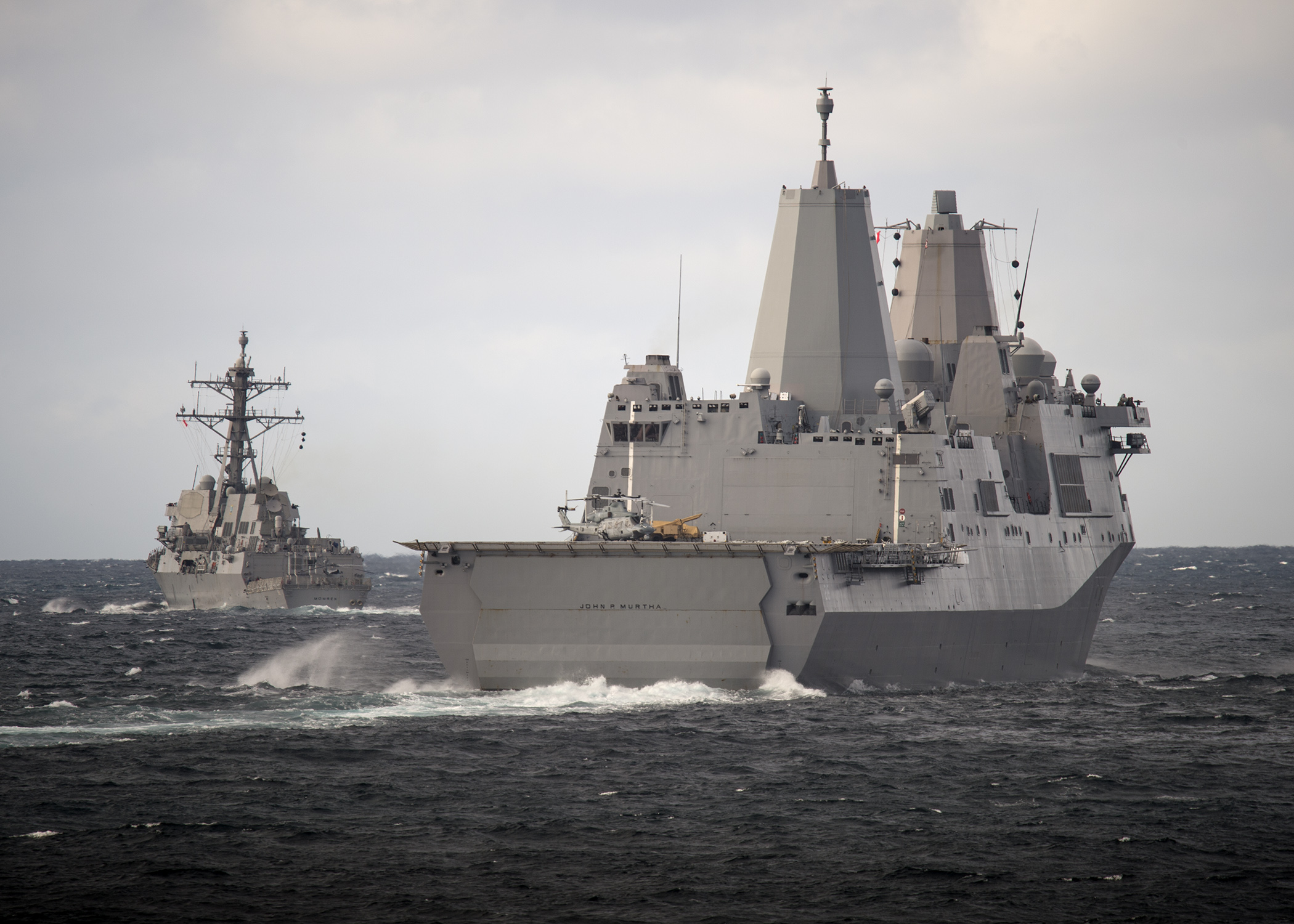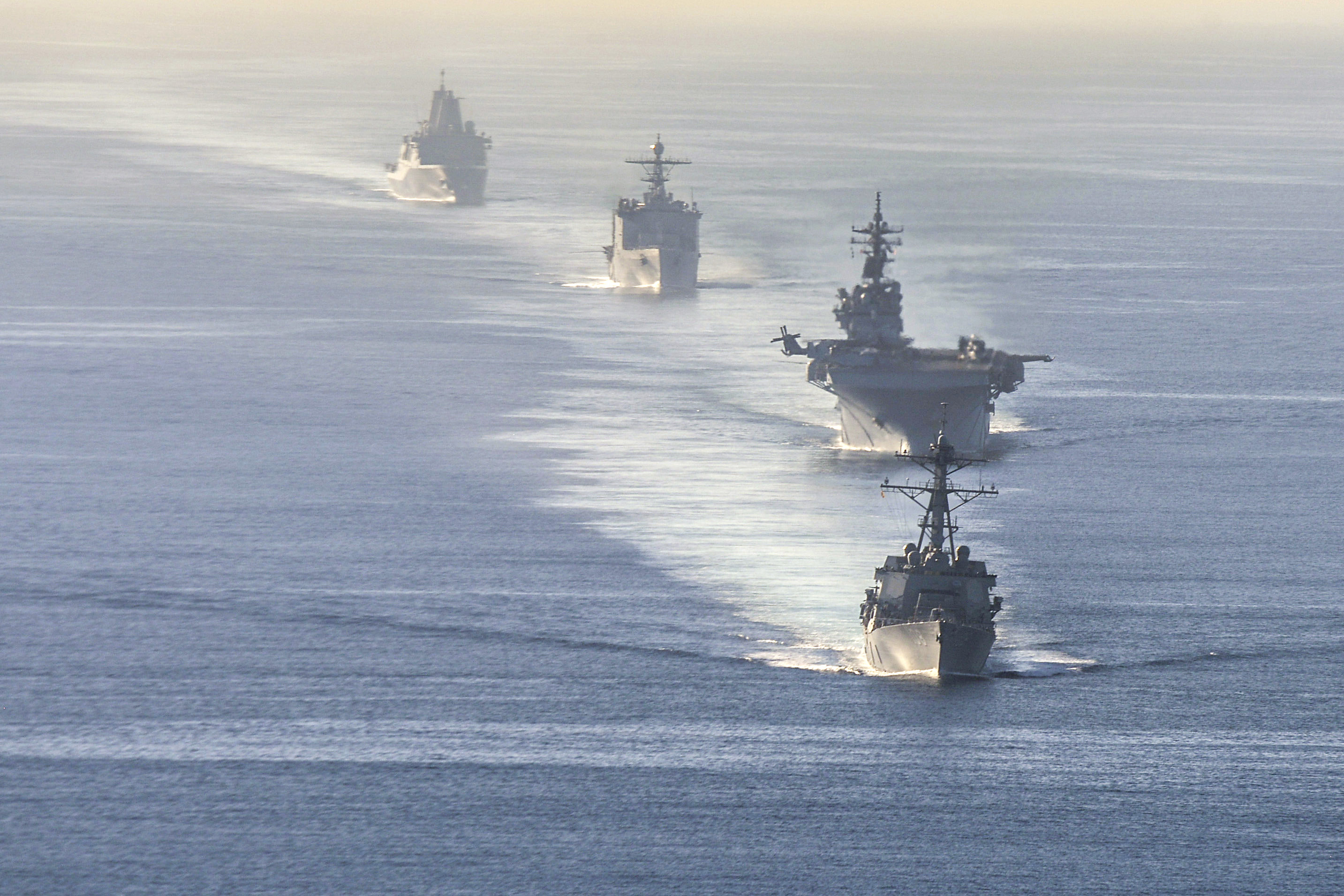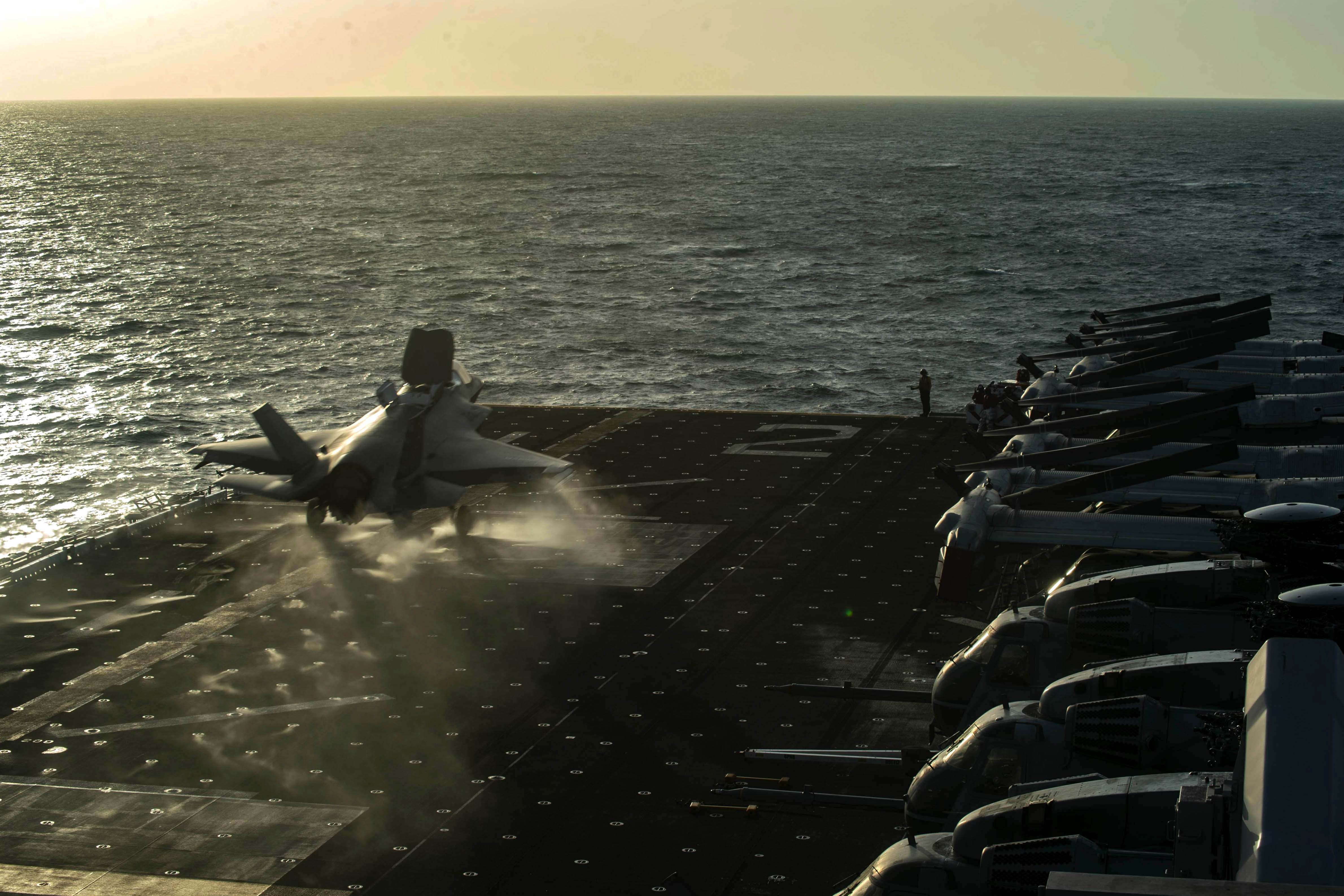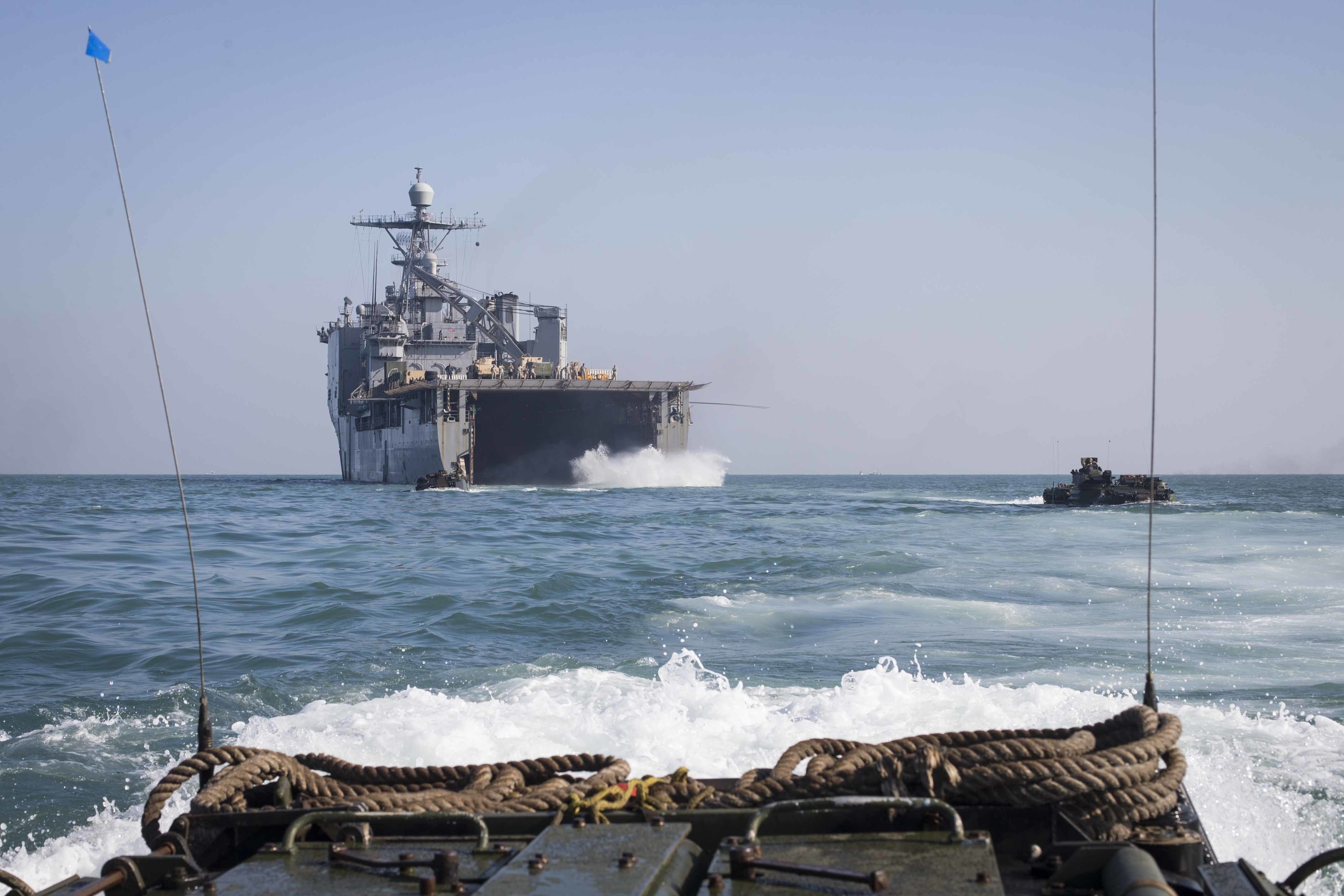
NATIONAL HARBOR, Md. – The Navy is committed to upgrading its amphibious ships to support the Navy and Marines’ new way of operating and to leverage the power of the F-35B Joint Strike Fighter, but it’s still unclear when dollars will start flowing to pay for these upgrades to communications and command and control systems.
Rear Adm. Jim Kilby, the Navy’s director of warfare integration, said last week that service leaders are looking at the command and control upgrades and logistics enablers to allow the Navy/Marine Corps team to conduct Distributed Maritime Operations (DMO) and Expeditionary Advance Base Operations (EABO), the two services’ concepts to address high-end warfare in the open ocean and the littorals. However, he acknowledged, those investments must be made while balancing other modernization efforts, rebuilding readiness and growing the force.
Amphibious ships, “in conjunction with things like the Joint Strike Fighter, are really changing the way we view those assets and how they would help us in this great power competition,” Kilby said during a panel on expeditionary warfare at the Navy League’s annual Sea Air Space conference last week.
“We’ve been focused for a long time on power projection ashore. And now there’s a balance that we have to think about in great power competition of sea control and power projection,” he said, adding that the Navy and Maries are looking at investments in things like long-range precision weapons so that Marines ashore can hold at risk enemy targets at sea.

Brig. Gen. Stephen Liszewski, the director of operations at Marine Corps headquarters, said during the panel that implementing the EABO concept is “fundamentally flipping the script, if you will, on a potential adversary. So now rather than trying to figure out how we might bring a cruiser or destroyer in close to be able to provide surface fire support for a landing force, we now, through the development of some of these capabilities, what we seek to be able to do is for the Marines ashore to be able to establish a firing capability that would then look outward and be able to strike targets in support of those cruisers and destroyers and those carrier strike groups as they work to achieve sea control. And that sort of fundamental change in capability and what we bring to the fight is all aimed at increasing our ability in different parts of the world, but also aimed at deterring in the mind of a potential aggressor his decision-making calculus on whether or not he may do something that would undermine the larger strategic objectives of the United States. So it really is all about how do we employ existing capability, how do we modernize it in order to be able to generate new effects in the environment we face.”
Despite the general acknowledgement that DMO and EABO are moving the services in the right direction, it is unclear when more money will start flowing for modernization and upgrades to support these concepts. The Marine Corps is trying to field a long-range anti-ship missile as fast as possible and is working with Raytheon to integrate the Naval Strike Missile with its existing infrastructure. A long list of remaining spending needs, though, are “a high priority,” Kilby said, but “I can’t answer that specifically now” as to when those spending items will be funded.
Frank DiGiovanni, deputy director for expeditionary warfare on the chief of naval operations staff (OPNAV N95B), said during the panel that Distributed Maritime Operations requires ships to be more lethal and more survivable, and so driving the development of concepts and strategy is the question, “how can we improve our ability to be more lethal and survivable?” That is also driving requirements for ship and connector improvements.

Among the priorities is increasing the offensive capability of the San Antonio-class amphibious transport dock, two flights of which will eventually account for 26 of the required 38 amphibious warships. N95 wants to pair the large well deck on the amphibious assault ships (LHA/LHD) with unmanned surface and underwater vehicles, it wants to leverage the Expeditionary Sea Base ship to launch unmanned platforms in all domains, and it wants to reduce the acoustic and radar signatures of connectors to allow them to be more survivable as they bring Marines and supplies ashore in a first assault and in follow-on resupply missions.
At the top of the list, though, is boosting the command and control capabilities of the amphibious assault ships to best leverage the massive amount of data the F-35B will soak up as it flies its missions. In particular, the Wasp-class LHDs cannot take in all the data the jets are collecting and share them with Marines aboard and with other ships in the fleet – something the amphibious community wants to fix.
“There’s a lot of threats that come from land, so working that connectivity between the [situational awareness] on the ground and also on the surface and in the air is an important part, we think, of the F-35B and our connectivity to the Marine Corps’ command and control system,” DiGiovanni said.

An amphibious warship capabilities evolution plan outlines the upgrades the Navy and Marine Corps want to invest in to boost connectivity, lethality and survivability of the amphibs to succeed in EABO and DMO in a high-end environment. Director of Expeditionary Warfare Maj. Gen. David Coffman last fall outlined his vision for amphib ship upgrades, which would include a mid-life overhaul period for amphibious assault ships — akin to the mid-life refueling and complex overhaul that aircraft carriers undergo — to give these ships the computers, the communications gear and more they need to fully leverage the F-35B.
“I don’t want to bring Marine Aviation down to third- and fourth-gen; I want to bring the rest of the Marine Air-Ground Task Force up to fifth-gen and exploit that technical expertise and have a fifth-gen MAGTF. The problem is, we’re having to embark a fifth-gen MAGTF on a third-gen ship, and we have to fix that. Time, now,” Coffman said in November 2018.
Kilby said in the panel discussion that “the [budgeting] process, informed by these capability evolution plans, now has a pretty robust conversation acknowledging the Marine Corps’ concepts that we’ve described here,” but he also made clear that any investments in these capabilities has to be balanced with other fleet needs, especially readiness drivers such as ship and aircraft maintenance.





